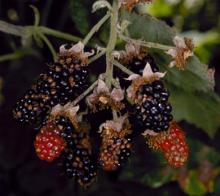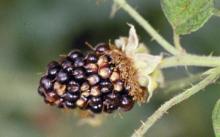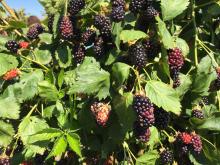See:
Raspberry (Rubus spp.) - Dry Berry
Cause Many fungi have been associated with dry druplets found on various blackberries in the Pacific Northwest. Many of these are common pathogens that produce other, more recognizable symptoms. The list includes those fungi that cause anthracnose, ascospora dieback, spur blight, cane and leaf rust, and Botrytis fruit rot. Other fungi of unknown pathogenicity also have been found. In general, the dry druplets have not been found to be associated with downy mildew, sunburn, or pests such as the dry-berry mite or brown marmorated stink bugs. Symptoms most often are found in years when late spring rains are numerous and frequent. Berries with these symptoms are not accepted into the more lucrative individual quick-freeze (IQF) markets. The problem has been widely found in 'Marion' and 'Kotata' with minor amounts in 'Boysenberry'. It has been a problem in both alternate-year and every-year fields.
Symptoms Individual druplets become shrivelled, dry and hard. In addition, some fruits may have small dry, scabby looking lesions on green, red, and black druplets. Affected druplets may be widely scattered on the berry or may be clustered in patches anywhere on the berry. Symptoms are seen anywhere from early berry development to ripening. Sporulation of various fungi may or may not be seen.
Control No one specific organism produces this symptom, so the suggested focus is on controlling the various diseases associated with this problem. Focus on those that historically have been troublesome in your field. Both cultural and chemical control programs may need to be extended when wet weather continues into late spring and summer.
Reference Martin, R.R., Ellis, M.A., Williamson, B., and Williams, R.N. 2017. Compendium of Raspberry and Blackberry Diseases and Pests. 2nd edition. St. Paul, MN: APS Press.





